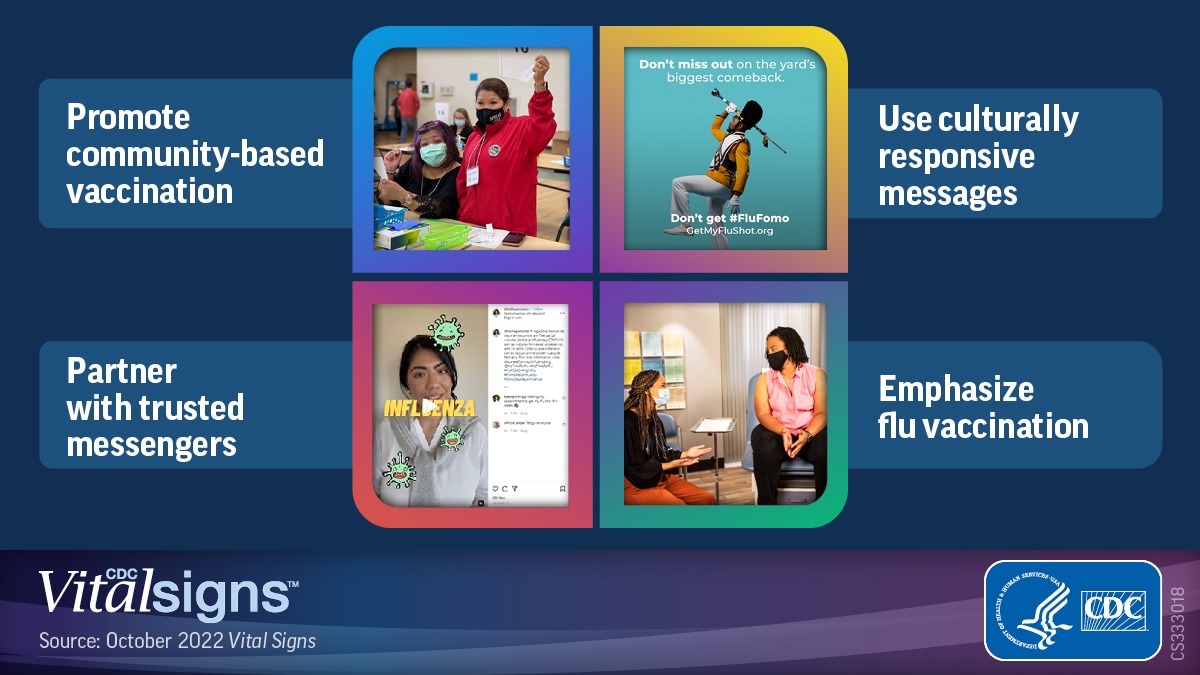Inequities Found in Flu Vaccine Uptake
Increasing flu vaccination through more targeted outreach can help lower disparities
Embargoed Until: October 18, 2022, 1:00 p.m. ET
Contact: Media Relations
(404) 639-3286
Black, Hispanic, and American Indian/Alaska Native (AI/AN) adults in the United States are more likely to be hospitalized with flu, as well as less likely to be vaccinated against flu, according to a new CDC Vital Signs report. CDC is working to increase flu vaccination rates by using proven strategies to raise awareness of how serious flu can be and break down barriers to vaccination.
The Vital Signs report looked at flu hospitalization rates from 2009–2022 and flu vaccination coverage from 2010–2022 by race and ethnicity, from two data sources, the Influenza-Associated Hospitalization Network (FluSurv-NET) and Behavioral Risk Factor Surveillance System (BRFSS).
“Flu vaccines are the best way to protect against flu and its potentially serious complications,” said CDC Acting Principal Deputy Director Debra Houry, M.D., M.P.H. “Improving access to and trust in flu vaccines among people is critical to help reduce inequities.”
Flu vaccination coverage has been consistently lower among Black, Hispanic, and AI/AN adults since 2010. During the 2021–2022 season, flu vaccination coverage was 54% among White and Asian adults, 42% among Black adults, 38% among Hispanic adults, and 41% among AI/AN adults.
Black, Hispanic, and AI/AN adults were hospitalized with flu at higher rates than White adults during most seasons from 2009 to 2022.* Compared to White adults, hospitalization rates were nearly:
- 80% higher among Black adults,
- 30% higher among AI/AN adults, and
- 20% higher among Hispanic adults.
There are many reasons for disparities in severe outcomes of flu, including lack of access to health care and insurance, missed opportunities to vaccinate, and misinformation and distrust that contribute to lower levels of confidence in vaccines. People from certain racial and ethnic minority groups have higher rates of asthma, diabetes, obesity, and other chronic conditions. These increase the risk for serious flu complications. Racism and prejudice also are known to worsen inequalities.
Over the past two years, CDC began programs to address barriers to flu vaccination and raise awareness about its importance, specifically among people from racial and ethnic minority groups. These include the Partnering for Vaccine Equity (P4VE) program and a targeted, national flu vaccination campaign. These programs use proven actions to help increase vaccination among people from racial and ethnic minority communities.
Health care providers, state and federal officials, and individuals can work together to fight flu by taking steps to increase vaccine uptake in everyone, including people from racial and ethnic minority groups.
- Health care providers can strongly recommend flu vaccination to patients and make culturally appropriate vaccine recommendations. This could include using materials with images representative of those in the community, providing information that is transparent and promotes the benefits of and reasons for vaccination, addressing community-specific concerns and misinformation, such as vaccine side effects or risk, and using the predominant language spoken in the community, such as Spanish.
- State and local governments should identify and remove barriers to vaccination and work with community organizations to increase access and convenience. Partnering with trusted messengers and promoting culturally relevant messages can build trust and confidence in vaccines and advance equity.
- Everyone should get vaccinated against flu today and encourage others in their community to get a flu vaccine for the best protection against flu this fall and winter.
For more information about this report, go to www.cdc.gov/vitalsigns.
*2020–2021 flu season excluded due to lack of data.
###
U.S. DEPARTMENT OF HEALTH AND HUMAN SERVICES
CDC works 24/7 protecting America’s health, safety and security. Whether diseases start at home or abroad, are curable or preventable, chronic or acute, or from human activity or deliberate attack, CDC responds to America’s most pressing health threats. CDC is headquartered in Atlanta and has experts located throughout the United States and the world.
